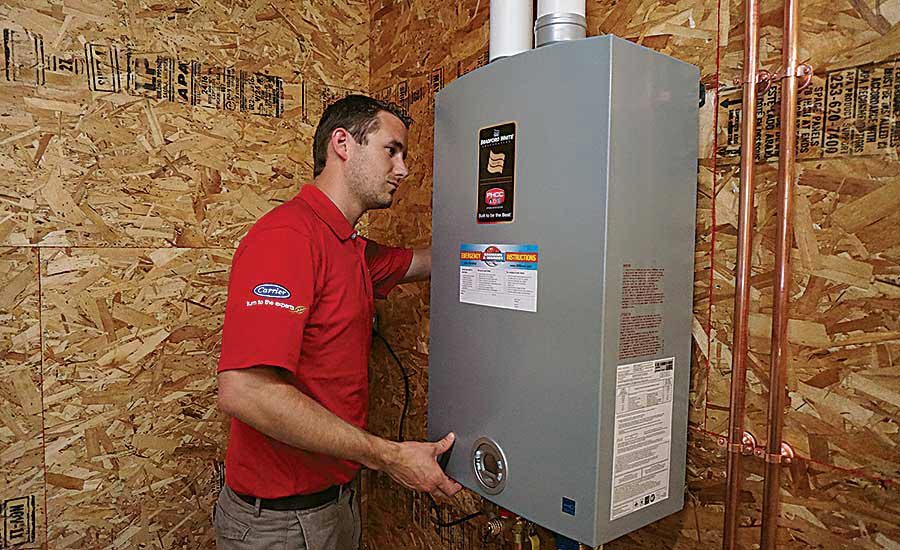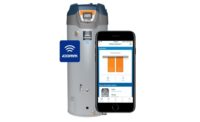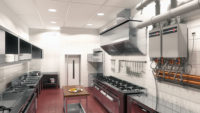Earlier this year Supply House Times talked to several manufacturers about trends they are seeing with toilets. One trend in particular that stood out is the consumer’s desire for remote connectivity even with a product such as a toilet.
That trend also is becoming more prevalent with water heaters. Supply House Times queried numerous water-heater manufacturers about trends they are seeing in the marketplace and just like with toilets, the connected aspect is front and center with consumers.
“’Connectivity’ options may likely become a more common water-heating product feature as ‘smart’ technology continues to become more popular and more accessible to consumers,” says Carl Pinto, Bradford White’s director of marketing.
Intellihot Founder and CEO Sri Deivasigamani sees the same shift occurring. “Water heaters, much like many other industries, are moving toward ease of control and visibility of information to the end user no matter where they are — whether inside the building or thousands of miles away,” he says.
Noritz Marketing Manager Andrew Tran adds that consumers see water heaters as part of their increasing wireless portfolio. “Manufacturers are increasingly incorporating wireless technology into their products to make them compatible with the ‘Internet of Things’ trend sweeping appliances in general,” he says. “Customers are embracing wireless connectivity in all aspects of their lives and water heating is no exception. Wireless-connected water heaters allow a level of monitoring and control previously unheard of in the industry as consumers and contractors can be constantly briefed on their units’ performance.”
Regulation talk
Water-heater manufacturers are gearing up for the final transition of the U.S. Department of Energy’s residential water-heater efficiency ratings from the Energy Factor metric to the new Uniform Energy Factor metric.
“The major reason for the implementation of this new system is to provide ratings that are both consistent and better reflective of everyday usage for all products that are intended for residential applications,” explains Ann Woodard, marketing manager of tankless water heater manufacturer Navien.
The move to the UEF system began in December 2016 and will be complete by December 2017. Woodard notes new EnergyGuide labels have been designed by the Federal Trade Commission that will be required to be used by all manufacturers beginning June 12 of this year.
“This will allow more ‘apples to apples’ comparisons between technologies,” A. O. Smith Vice President of Marketing David Chisolm says. “First-hour deliveries will be categorized differently — different ‘bins’ based on product performance. In addition, we will see slight changes in how storage capacity is listed, as allowable tolerances between rated and actual capacities have been reduced. The noticeable change will be a new format for the Yellow EnergyGuide sticker found on most residential water heaters. Most of this is informational to help consumers make better product comparisons or choices. However, it does merit monitoring these changes so our channel partners won’t be confused when they see these new figures.”
More trends
A. O. Smith’s Chisolm says there is increased interest in alternate technologies in the water-heating space, namely with electric heat-pump water heaters.
“These products have a tremendous value to the homeowner,” he says. “In many cases homeowners can pay for the difference in up-front cost in less than two years. Many regions also have lucrative utility rebates for these products, so often times the cost difference between a conventional product and a heat-pump water heater is minimal. These rebates can be for the end-user, the builder or even the distributor, so each stakeholder should take some time to familiarize themselves with the rebate environment in their region.”
Rheem Water Heating Division Director of Wholesale Sales John Andrews says his distributor partners are encountering a “much more educated customer base.”
“Contractors are trying to stay up to date on the latest high-efficiency product trends and technologies, and they’re hungry for more information,” he says. “There’s also added awareness of water-heater brands and specific offerings — including product solutions that continue to emerge such as tankless gas, hybrid electric and point-of-use tankless electric water heaters.”
Navien’s Woodard says the tankless portion of the business continues to gain in popularity. “The tankless water-heater market is and has been showing strong year-over-year growth,” she says. “To that end, there are new manufacturers promoting new tankless options as they try to gain a piece of the growing market share.”
In addition to new trends, some age-old ones remain firmly in place when it comes to water heaters, namely the desire for energy efficiency and cost effectiveness.
“Many consumers are starting to look at the energy efficiency of their water heaters much in the way they’ve been looking at their other household appliances the last few decades,” Bradford White’s Pinto says. “With the increased consumer focus on water-heater performance, manufacturers are looking to improve their current designs and develop new technologies.”
As far as the overall construction outlook, Pinto is predicting water-heater manufacturers will be busy in the upcoming months. “We’re confident that an uptick in new residential construction will continue to boost demand for new water-heating products,” he says. “A considerable part of this growth is expected to be in multi-family housing projects. Given that water-heating preferences by builders vary greatly within the multi-housing arena, manufacturers like Bradford White — offering a broad range of water-heating technology — should expect to have many opportunities in 2017 and beyond. Also, all indications are that the replacement market trends will be on par with last year, providing water-heater manufacturers ample opportunities for growth. Many reports suggest this positive trend is expected to continue through at least 2021.”
Noritz’s Tran is hearing the same increased interest in the remodel/retrofit arena. “We are observing an increased interest in the retrofit market based on distributor reports,” he says. “This is, in turn, sparking an interest in water heaters that can be installed quickly and easily, replacing the old unit with the least amount of effort and using existing connections to the greatest extent possible. Units that can utilize existing venting, gas-line and water connections are highly demanded by consumers.”
Intellihot’s Deivasigamani says the water-heater industry will continue to evolve in the years to come. “There is a confluence of owning and operating cost, reliability and size of equipment,” he says. “This has been fueled by modular technology coupled with the ‘Internet of Things,’ or IoT as it is more popularly known. The domestic hot-water heating market is heading into a new age. We expect more changes in the next 10 years than what has happened in the last 100 years of water heating.”
New products
A quick look at some new water-heater technologies.
Navien Ready-Link: This rack and manifold system for commercial installations is a kit-of-parts that allows easy on-site assembly for Navien tankless water heaters on either a rack or wall.
Bradford White eF Series: This high-efficiency residential power vent water heater has a thermal efficiency of more than 90% and a higher hot-water recovery.
Noritz EZTR50 and EZTR75: These tankless systems offer increased venting options and have outdoor conversion kits, broadening installation options.
Intellihot telliBot: This device transforms every water heater or boiler into a smart device and monitors the boiler room for safety.
A. O. Smith Voltex hybrid electric heat-pump water heater: Updated line allows for Voltex installation in all climates (including colder ones). A duct kit accessory enables installation in limited-space applications.
Rheem Prestige hybrid electric water heater: Features exclusive EcoNet built-in leak-detection system that sends a notification to a smartphone if a leak is detected and sets off water-heater alarm.
This article was originally titled “Electronic super-highway” in the April 2017 print edition of Supply House Times.









